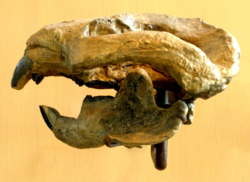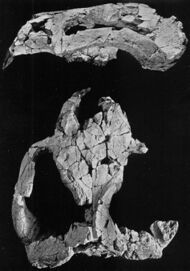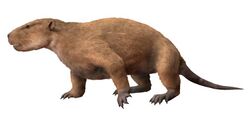Biology:Taeniolabis
| Taeniolabis | |
|---|---|

| |
| Taeniolabis taoensis | |
| Scientific classification | |
| Domain: | Eukaryota |
| Kingdom: | Animalia |
| Phylum: | Chordata |
| Class: | Mammalia |
| Order: | †Multituberculata |
| Family: | †Taeniolabididae |
| Genus: | †Taeniolabis Cope, 1882 |
| Type species | |
| Taeniolabis taoensis Cope, 1882
| |
| Other species | |
| |
Taeniolabis ("banded incisor")[2] is a genus of extinct multituberculate mammal from the Paleocene of North America.
Description
Taeniolabis is a member of the Taeniolabidoidea, a superfamily of multituberculates that are known for their highly derived teeth, and a short wide snout with a blocky head. [3] The teeth modifications were likely an adaptation for herbivory that may have resulted from rapid diversification of angiosperms at the very end of the Cretaceous, which would thus have created opportunities for novel specialization in herbivores.[4] It is the largest known multituberculate, as well as the largest allotherian mammal. [5][6] Species under this genus have been known under other names.[7] Taeniolabis taoensis is found frequently enough and in a very limited time range that it can be used as an index fossil for the Puercan faunal stage within Danian aged fossil deposits.[8][9]
Taxonomy
History
It is within the suborder of Cimolodonta and is a member of the superfamily Taeniolabidoidea. The genus was named by Edward Drinker Cope in 1882. [10] Species have also been placed with the genera Catopsalis and Polymastodon.
Species
- Taeniolabis lamberti was named by Nancy Simmons in 1987. [11] It has been found in the Danian aged Tullock Formation of Montana. It is not quite as large as T. taoensis, but still a hefty size for a multituberculate.[clarification needed][citation needed]
- Taeniolabis taoensis was originally named Taeniolabis sulcatus by Cope in 1882 as the type species of the genus.[12] It was later renamed as T. taoensis. Known fossils date to approximately 64 million years of age. [13]They are found in Danian aged deposits of the Nacimiento Formation of New Mexico, the Ravenscrag Formation of Saskatchewan and the Denver Formation of Colorado. [14]This species likely had a roughly16 centimetres (6.3 in) long skull and had an average body mass of 22.7 kilograms (50 lb), which is approximately the size of a modern beaver. The species was once considered to have had a body mass of up to 100 kg and sized like a sheep[15] or larger by extrapolating body size on the basis of their huge teeth. However, improved analyses and the realization that the teeth were extraordinarily robust due to herbivory rather has generally disproved that.[16][17]
Notes
- ↑ Simmons 1987, pp 802-804
- ↑ Palmer 1904, p 659. From Greek
- ↑ Kielan-Jawoworska and Hurum, 2001
- ↑ Wilson et al, 2012, pp 458-459
- ↑ Rose 2006, p 60
- ↑ Krause et al 2021, p 1085
- ↑ Palebiology Database
- ↑ Simmons 1987
- ↑ Krause et al 2021, p 1085
- ↑ Cope 1882, pg 604-605
- ↑ Simmons 1987, pp 802-804
- ↑ Cope 1882, pg 604-605
- ↑ Wilson et al, 2012 Supplemental Table 5
- ↑ Krause et al 2021, p 1086
- ↑ Cope 1882, p 605
- ↑ Krause et al 2021, p 1085 with lengthy discussion about estimates of size
- ↑ Wilson et al, 2012 Supplemental Table 5
References
- Cope, E.D. (1882). "Geology and Paleontology, A new genus of Taeniodonta". American Naturalist 16 (7): 604-605.
- Dykes, Trevor. "Mesozoic Mammals; Eucosmodontidae, Microcosmodontidae and Taeniolabidoidea, an internet directory". http://home.arcor.de/ktdykes/taenio.htm.
- Kielan-Jaworowska, Zofia; Hurum, J.H. (2001). "Phylogeny and Systematics of Multituberculate Mammals". Paleontology 44 (3): 389-429. doi:10.1111/1475-4983.00185.
- Krause, David W.; Hoffmann, Simone; Lyson, Tyler R.; Dougan, Lindsay G.; Petermann, Holger; Tecza, Adrienne; Chester, Stephen G. B.; Miller, Ian M. (13 December 2021). "New Skull Material of Taeniolabis taoensis (Multituberculata, Taeniolabididae) from the Early Paleocene (Danian) of the Denver Basin, Colorado". Journal of Mammalian Evolution 28 (4): 1083–1143. doi:10.1007/s10914-021-09584-3. PMID 34924738.
- Palmer, T.S. (1904). "Index Generum Mammalium: a List of the Genera and Families of Mammals". North American Fauna 23: 659. doi:10.3996/nafa.23.0001. https://www.biodiversitylibrary.org/item/88553#page/197/mode/1up. Retrieved 31 October 2019.
- Rose, Kenneth David (2006). The beginning of the age of mammals. Baltimore: JHU Press. ISBN 978-0801884726. https://books.google.com/books?id=3bs0D5ix4VAC.
- Simmons, Nancy B. (1987). "A Revision of Taeniolabis (Mammalia: Multituberculata), with a New Species from the Puercan of Eastern Montana". Journal of Paleontology 61 (4): 794-808.
- Williamson, Thomas E.; Brusatte, Stephen L.; Secord, Ross; Shelley, Sarah (May 2016). "A new taeniolabidoid multituberculate (Mammalia) from the middle Puercan of the Nacimiento Formation, New Mexico, and a revision of taeniolabidoid systematics and phylogeny: Revision of Taeniolabidoidea". Zoological Journal of the Linnean Society 177 (1): 183–208. doi:10.1111/zoj.12336.
- Wilson, Gregory P.; Evans, Alistair R.; Corfe, Ian J.; Smits, Peter D.; Fortelius, Mikael; Jernvall, Jukka (2012). "Adaptive radiation of multituberculate mammals before the extinction of dinosaurs". Nature 483: 457-460. doi:10.1038/nature10880.
Further reading
- Cope, E.D. (1882). "Mammalia in the Laramie Formation". American Naturalist 16 (10): 830-831.
- Kielan-Jaworowska, Zofia; Hurum, J.H. (2001). "Phylogeny and Systematics of Multituberculate Mammals". Paleontology 44 (3): 389-429. doi:10.1111/1475-4983.00185.
- Osborn and Earle (1895), "Fossil mammals of the Puerco beds." Collection of 1892. Bull. Amer. Mus. Nat. Hist. VII, p. 1-70, with 21 figs.
- Granger and Simpson (1929), "A revision of the Tertiary Multituberculata." Bulletin Amer. Mus. Nat. Hist. 56, p. 601-676, 43 figs.
Wikidata ☰ Q768875 entry
 |




